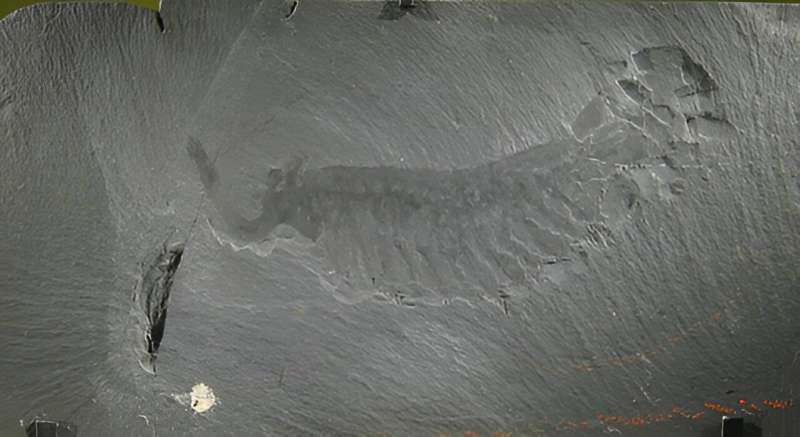This article has been reviewed according to Science X's editorial process and policies. Editors have highlighted the following attributes while ensuring the content's credibility:
fact-checked
peer-reviewed publication
trusted source
proofread
Small change in Earth's oxygen levels may have sparked huge evolutionary leap

New research provides the clearest evidence yet that the Cambrian explosion—a rapid burst of evolution 540 million years ago, could have been triggered by only a small increase in oxygen levels in Earth's atmosphere and shallow ocean waters.
The new study published today in Nature Geoscience brings together datasets from an international consortium of scientists to show that minor increases in oxygen are may have been sufficient to propel major evolutionary leaps seen in the fossil record.
Lead author of the study Dr. Richard Stockey , a paleobiologist at the University of Southampton who worked on the research as a Ph.D. student at Stanford University, said, "The Cambrian explosion was a remarkable period of rapid diversification of life on Earth. Previously, life consisted of single cell and small multicellular organisms.
"Then, within 20 or 30 million years, a geological blink, we see a variety of strange and complex creatures emerge with new body plans and features like mineralized shells, grasping appendages, and complex sensory organs like eyes."
Just enough oxygen
For decades, scientists have theorized that the Cambrian explosion was prompted by a sudden rise in atmospheric oxygen that brought oxygen in the ancient ocean close to modern levels. But the evidence for this has been scattered and, in some cases, contradictory.
By conducting a comprehensive, large-scale data analysis, researchers have identified just a small increase in atmospheric oxygen at the time of the Cambrian explosion.
"Cambrian animals likely did not require as much oxygen as scientists used to believe. We found minor increases in oxygenation that are at the correct magnitude to drive big changes in ecology," says senior study author Erik Sperling, an associate professor of Earth and planetary sciences at the Stanford Doerr School of Sustainability who leads the consortium.
Most animals were living in shallow water at the time, and mixing caused by wind and waves would have oxygenated these areas even as the deeper ocean remained unchanged.
"It's not a huge increase in oxygen, but it might be enough to cross critical ecological thresholds, based on what we see in modern areas with naturally low oxygen," adds Sperling.
The researchers also found evidence that oxygen levels in the deep ocean did not approach those in modern seas until about 140 million years after the Cambrian explosion—much later than previously thought.
Dr. Stockey says, "From a global perspective, we didn't see the full oxygenation of the oceans to near modern levels until about 400 million years ago, around the time that we see the appearance of large forests on land."
Unearthing the answers
To investigate changes in oxygen over 700 million years of Earth's history, researchers examined data showing levels of uranium and molybdenum in black shale—a sedimentary rock formed in low-oxygen environments on the bottom of ancient oceans.
These metals accumulate in sediment when oxygen is low, so their concentration in black shale indicates past oceanic oxygen levels.
Previous studies noted increased trace metals in black shale during the Cambrian explosion, but these have mostly been based on data from individual field sites, where local factors such as an increase in organic carbon can increase trace metal concentrations.
Using statistical and machine learning techniques, the researchers analyzed data on a much larger scale and used oceanographic models to estimate historical oxygen levels.
"We found that changes in organic carbon in black shale have driven a lot of the changes in trace metals that scientists have been seeing for the last 15 or 20 years," says Dr. Stockey. "It's not until 140 million years after the Cambrian explosion, in the Devonian period, that we see trace metals increasing at a rate that would indicate whole ocean oxygenation."
A consortium for geochemical data
The black shale data were compiled as part of the Sedimentary Geochemistry and Paleoenvironments Project, a first in its field research consortium that brings together geochemical data in a standardized database for large-scale analysis.
"It's a very different approach than we've used in the field before," says Sperling, who launched the consortium in 2015. "Each individual research group, including ours, is still going out to the field and getting a snapshot of what's going on, but then we need to all come together to analyze things."
The analytical toolkit that Dr. Stockey developed for this work could help researchers understand not only ancient oxygen levels, but also temperature, food supply, and other potential drivers of early evolution. Consortium members are also collecting new data to fill in periods of geologic time that are under-sampled and conducting analyses that expand into older and younger time intervals.
"To harness the power of these more advanced data science approaches, particularly for geological data, we need everyone to be speaking the same language," says Dr. Stockey. "This community-driven data science approach has allowed us to be way more confident about the way we reconstruct Earth's evolution in space and time."
More information: Richard G. Stockey et al, Sustained increases in atmospheric oxygen and marine productivity in the Neoproterozoic and Palaeozoic eras, Nature Geoscience (2024). DOI: 10.1038/s41561-024-01479-1
Journal information: Nature Geoscience
Provided by University of Southampton




















